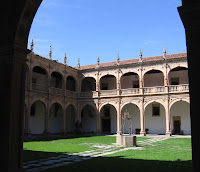
Salamanca, Day 1: I hate flying east. There’s a 9-hour time difference between Seattle and Western Europe, and I have yet to discover how to deal with it effectively. Flying west is no problem. In fact, it’s somehow energizing to have an extra 9 hours in the day. Flying east I’ve tried taking a melatonin and attempting to sleep on the plane. It doesn’t work. I’ve tried staying up the entire time and crashing the afternoon of the day I arrive, sleeping through until the following morning. This works better, since it sort of mimics the extra-long day. It’s the strategy I use when traveling alone, but this time we slept on the bus from Madrid to Salamanca, and stayed up late afterwards, walking around town. Big mistake. Both my mate (who shall hereafter be referred to as M) and I had tremendous jet lag this morning, sleeping until 11:00 and feeling like we were at death’s door. It felt like a horrible hangover without having drunk any alcohol.
The hotel is very civilized in that they serve their breakfast buffet until 11:30, so we made it down there just in time to partake. I normally don’t eat breakfast, but when I saw the gorgeous array of cut fruit that was on the table I changed my mind. There was watermelon, some sort of yellow melon, and cherries, all favorite foods. I even had a glass of orange juice before the coffee was served, something unheard of since I usually find orange juice too sour to drink in the morning. For some reason the smell and taste of the fruits was an excellent remedy for jet lag. M’s theory is that it’s the potassium. Maybe that’s the explanation, since I know I got really dehydrated on the flight and subsequent 2.5-hour bus ride across the flat, brown, and hot Castillan plateau. However, I know I felt better as soon as I saw and smelled the fruit, so there was some sort of placebo or expectation effect as well. Fruit and a hot shower with orange-scented soap have enabled me to sit at my computer and write, which is more than I could have done before. In fact, I feel remarkably good. It’s amazing what a little fruit can do.

















